Should I Learn This Step?
The step in the demo above is exaggerated. And also, it's not tango, because it's not answering to any music—but let's use it as a way of identifying what happens when we add a little leg bend to the end of our step. What we have done is taken our basic straight-leg tango step, and added some knee bend around the high point where the heels pass. As the heels pass, we smoothly bend our supporting leg, and then straighten it a bit to push off, just before the other foot strikes the floor. But be careful—this step is a minefield. It's a Pandora's box, and it comes with warnings:
1. If you aren't completely comfortable and proficient with the straight-leg walk, then you don't have a chance of doing this step well. Learn how to walk over a straight leg first, before attempting this one. If you don't, you may have a mess on your hands.
2. Use it only to answer to something in the music. Walking around the floor taking big, aggressive swooping steps all night long is like writing in CAPITAL LETTERS, AND USING EXCLAMATION POINTS ALL THE TIME!! IT MAKES YOU LOOK RIDICULOUS !!
It's important to land on a straight leg, and begin to rise up before you bend the knee. Then, the bend can come early, right after the foot strikes the floor (which means you won't rise as high over a straight leg), or it can come late after passing the high point of the step, which gives a little additional drop and forward momentum at the end. You can also flex the leg a lot, or a little, depending on what you want to say. You can see that El Chino likes to use it in a two-step combination. He waits for the part of the music he wants, and then takes a short, quiet step with early leg bend so there's not much up and down movement. Then he rises up on a straight leg in the second step and puts in a lot of leg flex from the top, which results in a more emphatic forward drop, and more rise at the finish. He has mastered this technique. He knows every note and nuance of the tangos, and he uses the step like a musical instrument to play along with them.
You can use El Chino's two-step, small-big combination, but you could also use a single big step out of a pause. When you have the right music (De Angelis' Como se Muere de Amor, for example), using giros and this single big step after a pause is a good way to deal with a very crowded floor. If you have more room, you can add it to a corrida of normal steps. An example might be the big dip we did with the marking pen to Di Sarli's Gran Muñeca on page 21.
Let's look at some common walking mistakes.
Creeping
Instead of using good technique by standing tall over a straight leg, and stepping onto a straight leg like this:
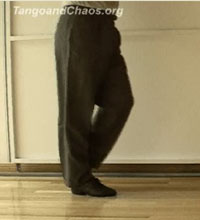
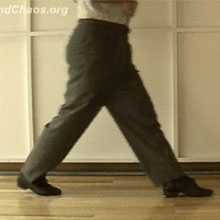
We stand with the knees bent, and step onto a bent knee:
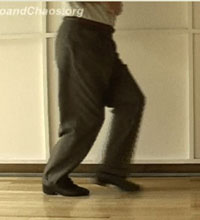
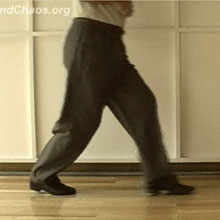
This is called "Caminan con las rodillas" (Walking on the knees), or Creeping. Here's how it looks:
When you don't step onto, or off of, a straight leg, the result can be flat movement with no musical up and down, and no forward acceleration and deceleration to mark the compás.
The Egg Walk
The next mistake is not keeping the weight forward. Instead of stepping forward with the body centered over a straight leg (first picture), we keep our weight back, and reach a bit with our leg (second picture):
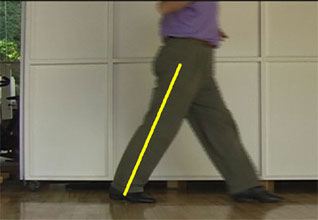
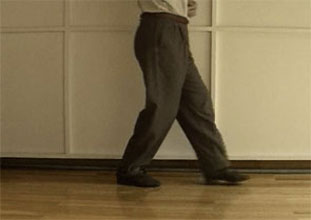
Here's how it looks. It's called "caminan pisando huevos"—stepping on eggs, or The Stroll:
This is similar to the way most of us walk naturally, but it has two problems: reaching, and flexing on impact. The leg reaches out for the step, while the weight stays back. We may straighten the leg just before impact, but then we immediately flex it a little to absorb the shock. The result is a light step.
There's a fellow in the U.S. who promotes his tango lessons with the slogan, "If you can walk, you can dance tango." He has a web site with demos of his teaching—and in almost all of them he is "pisando huevos". His walking is so soft that it looks like he really could walk over cartons of eggs without breaking them. He keeps his weight back, and bends his leg as soon as he steps to soften the impact. He even has a habit of stopping in mid-stride to explain to the class what he's demonstrating. He stands there with his legs apart, talking, while his weight is evenly supported on each leg. Wrong, wrong, wrong.
The man's half of tango, at least in the milongas, should be danced into the floor. Your supporting leg should carry all your weight, and when you step onto the new leg, all your weight should go to it right away. You do that by staying forward, and by keeping your leg straight after you step onto it.
On the next page, we'll combine a couple of bad habits with the step at the top of the page. It won't be pretty.

